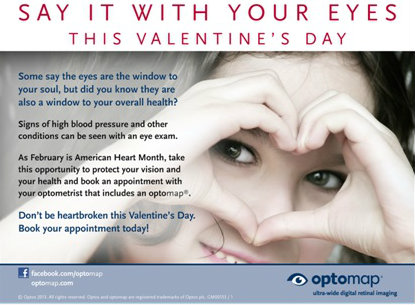With Valentine’s Day falling in February, it’s only natural for the American Heart Association to declare February American Heart Month. Heart disease is the leading cause of death in the U.S. for both men and women, accounting for one in four deaths annually.

While your patients may not believe it, there are some connections between the eyes and heart disease. Studies have shown that when higher levels of lipids are found in one’s blood, they “develop raised yellow patches of skin around the eyelids, known as xanthelasma,” (The New York Times Well Blog). Once thought to be purely a cosmetic issue, Danish researchers later found these spots indicators of underlying cardiovascular disease, and that those with spots were more likely than others to suffer a heart attack or death due to heart disease.
Researchers at the Centre for Eye Research Australia (CERA) also studied the topic in a project funded by the Medical Benevolence Foundation (MBF). The study showed that “blood vessels of the retina can be photographed and the images analyzed by a computer to accurately determine a person’s risk of heart attack or stroke.”
Even if your practice isn’t located in the U.S., February is a great time to talk to patients about the connection between heart disease and the eyes. Get the conversation started by discussing how our bodies’ interconnected systems make it possible to detect changes in our overall health long before we experience obvious symptoms. Remind them that just because they aren’t experiencing symptoms doesn’t mean they aren’t at risk. Also, share examples of how routine eye exams with an optomap® have helped detect systemic issues such as high blood pressure.
What talking points do you use to discuss the connection between heart disease and the eyes with your patients? Share with us in a comment below.
Practitioners interested in learning more about how Optos’ optomap® technology can help diagnose vision and systemic issues may request a consultation for more information.